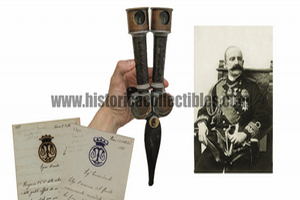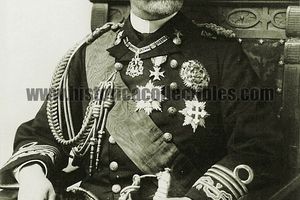Relief-Fernrohr 8x, Carl Zeiss Jena D.R.P., Belonged to Prince Tommaso of Savoy, about 1894
Relief-Fernrohr 8x, produced by Carl Zeiss, in 1894, belonging to Tommaso di Savoia Genova, Italian Admiral, Lieutenant General of the Kingdom of Italy from 1915 to 1919, Italian Royal Prince, nephew of Vittorio Emanuele II King of Italy, brother of queen of Italy daisy, cousin and brother-in-law of King Umberto I and uncle of King Vittorio Emanuele III. Furthermore, he was the consort of Isabella of Bavaria, daughter of Prince Adalbert of Bavaria and of Amalia Filippina of Bourbon-Spain.
In fact, his personal monogram is embossed in gold on the leather case.
The Relief-Fernrohr has a very low double-digit serial number (it is among the first 25 products) and this leads it back to one of the first Relief-Fernrohr and optics produced by Carl Zeiss.
Its small size (19 cm high) the weight of only 530 grams, as well as its accurate fineness, made this hyposcope much appreciated in those years among high-ranking officers and wealthy personalities always in vòga and constantly attentive to the revolutionary technologies of the optical sector. who never missed the opportunity to buy these important and particular innovations and put them on display, also because the practicality of its small size, among other things, allowed it to be worn around the neck like binoculars but well different was the attraction for those who observed him with curiosity.
This Relief-Fernrohr comes with its original carrying case.
The view is perfectly clear and collimated and all the mechanisms work perfectly.
Tommaso Alberto Vittorio of Savoy-Genova (Turin, 6 February 1854 – Turin, 15 April 1931) was a member of the House of Savoy, belonging to the Savoy-Genova branch, and an Italian admiral. He was Lieutenant General of the Kingdom of Italy, from 1915 to 1919.
Thomas of Savoy-Genova was born in the Palazzo Chiablese in Turin on 6 February 1854, son of Ferdinand of Savoy-Genoa and Elizabeth of Saxony. He was the younger brother of Margherita of Savoy, queen of Italy. Having lost his father when he was only one year old and having succeeded him in the title of Duke of Genoa, Tommaso was placed under the tutelage of his uncle Vittorio Emanuele II, who followed his education by sending him to study at the Harrow School in London.
Dedicated to sporting life, Tommaso was destined for a career in the Royal Navy and attended the naval school in Genoa. In 1873 he visited Japan with the rank of ensign. From 31 March 1879 to 20 September 1881, with the rank of frigate captain, he sailed around the world in command of the corvette Vettor Pisani, an Italian warship on its third oceanic campaign; during the crossing he was promoted to the rank of captain.
He became admiral in 1901.
Upon Italy's entry into the First World War, Vittorio Emanuele III decided to move from Rome to the front, entrusting part of his royal functions to Thomas, appointing him lieutenant general of the kingdom for the occasion. The position, however, was almost exclusively honorific and did not involve an effective exercise of power by the Duke of Genoa. However, in that period, the royal decrees were called lieutenant decrees and bore, rather than the king's signature, that of Prince Thomas. The lieutenant was also called to directly deal with the emergency caused in central Italy by the Avezzano earthquake, which occurred a few months earlier, on 13 January 1915.
He remained in office until 6 July 1919.
He died in Turin in 1931.
Carl Zeiss takes its name from its founder, Carl Zeiss, who on November 17, 1846 chose the small town of Jena, in Thuringia, as the location for his precision optical equipment factory. Thanks to the severe quality control that Carl Zeiss imposed on his products, going so far as to personally destroy the microscopes that did not pass the tests, the newly formed Zeiss became the official supplier of the University of Jena and received the gold medal of the industrial exhibition in 1861 of Thuringia as the best research instrument produced in Germany, awarded to the Stand I microscope of 1857.
In 1866 the thousandth microscope was produced and the name Zeiss became known throughout European scientific circles. Thanks to studies on the Porro prism, in 1893 Abbe patented double prism binoculars, which accentuated the perception of depth.
The mass production of Zeiss binoculars began in 1894, already at the beginning of the twentieth century more than 30,000 were made, at the beginning of the First World War the quota had risen to 500,000 and, at the end of the Second World War, as many as 2,260,000 were produced binoculars for the civil and military market. Models were made starting from 4x11 mm to 12x40 mm, up to real giants such as the 80 mm and 100 mm.
Thanks to studies conducted on the perception of light in low light situations, it was demonstrated that the average dilation of the pupil in an adult is approximately 7 mm. For this reason, the 7x50 mm model was introduced in 1910 and remained on the market until 1917 with few changes to the materials used.
In 1926, following the post-war crisis of the First World War with the Treaty of Versailles which bankrupted many important German companies, Zeiss purchased "C.P. GOERZ" and founded Zeiss Ikon in 1926.
In 1937 Zeiss had commercial contacts and factories in more than 29 countries around the world. From '33 Zeiss acquired interest from the Nazi regime, which balanced production towards military instruments. It successfully produced binoculars with wide-angle optics for military use, pressure-resistant optical systems for U-boats, periscope binoculars for targeting tanks. Furthermore, Zeiss cameras were mounted on the V2s for remote sensing operations of the English coasts.
On 1 November 1935, Zeiss, in the figure of Alexander Smakula, patented a process for the treatment of optical glass with extraordinary results in terms of light transmission. Remained a military secret until 1939, it was adopted on binoculars to reduce ghost images and internal reflections. During the Second World War, there were numerous bombings against the Zeiss factories.
Jena was bombed several times by the Allies starting in 1944. Stuttgart was razed to the ground, although the Contessa-Nettel factory suffered little damage. The bombing of Dresden, in addition to devastating the city, also caused considerable damage to the Zeiss Ikon headquarters. On April 13, 1945, American military forces entered Jena, surprising themselves that the bombing had not caused any significant damage. The main planetarium was in ruins, while the factories remained operational.



